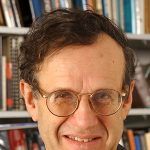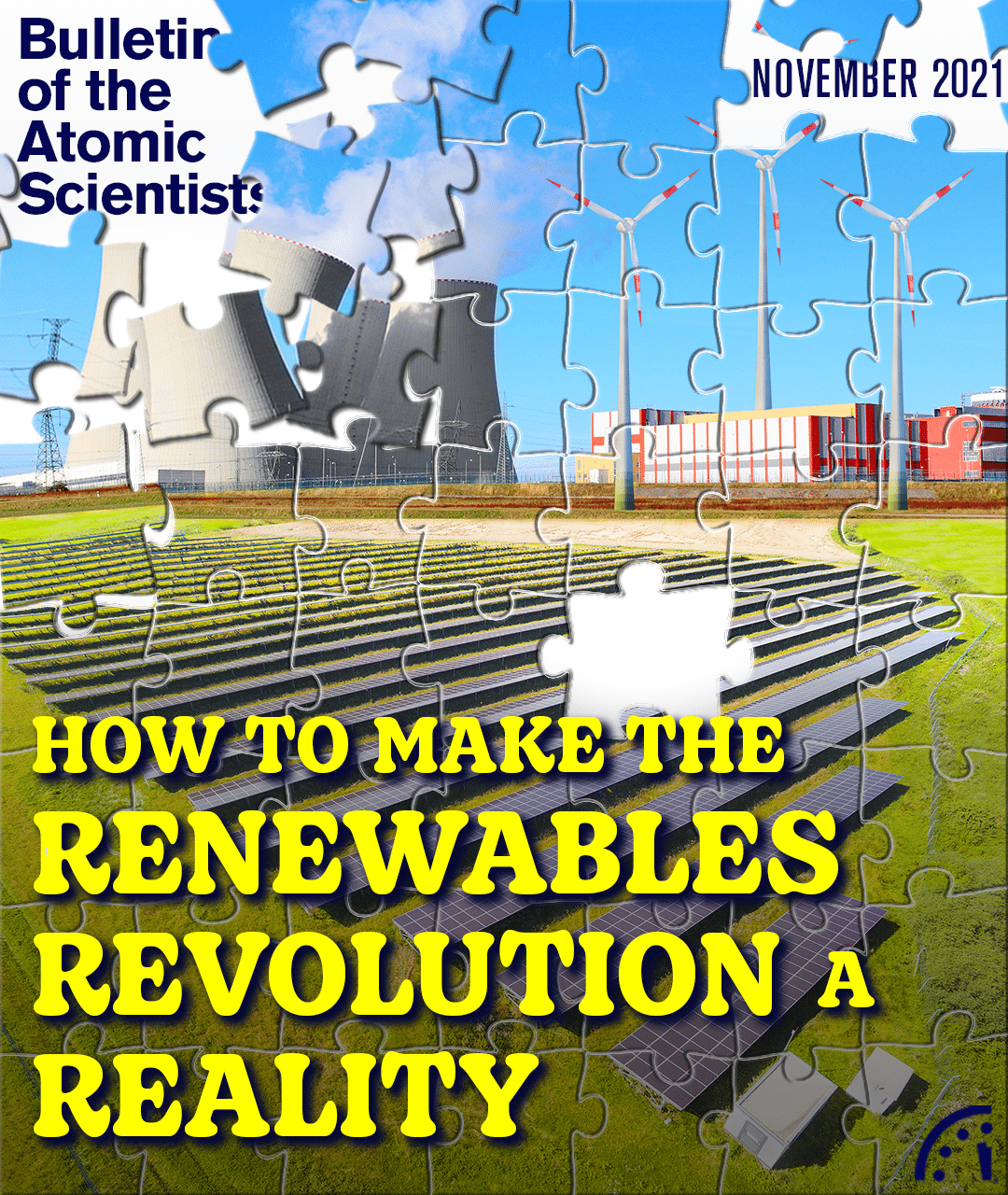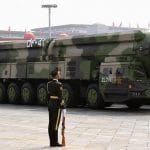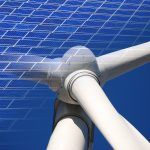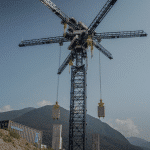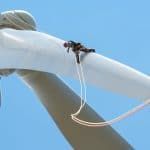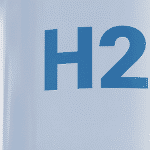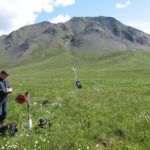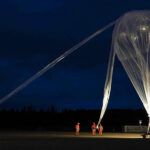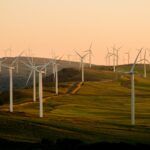Is nuclear power sustainable in a carbon-free world? The case of Sweden.
By Robert Rosner, Sabrina Fields | November 15, 2021
Is nuclear power sustainable in a carbon-free world? The case of Sweden.
By Robert Rosner, Sabrina Fields | November 15, 2021
Most scientists and policymakers agree that the energy sector, especially electricity generation, needs to be largely decarbonized by the turn of this century, but they differ on the means by which decarbonization should be accomplished. A variety of low-carbon emission energy technologies currently compete, ranging from fuel-free renewable technologies such as hydroelectric power and wind, solar, and tidal power to fuel-dependent technologies such as biofueled thermal power, nuclear energy, and fossil fuel-based thermal power coupled to efficient carbon capture and sequestration or reuse.[1]
Ultimately, this competition will be settled on the basis of technological readiness and capability, cost competitiveness, and specific technological constraints. For example, hydropower requires building new dams and storage reservoirs, which leads to environmental impacts; biofuels compete with food production for arable land; carbon capture and storage requires safe carbon dioxide storage sites; and nuclear power has raised questions about the safety of both the nuclear power plants and the long-term storage of nuclear waste, as well as the possible role played by nuclear power in nuclear weapon proliferation.
Nonetheless, nuclear power is a low-carbon, relatively mature technology that is well-suited to provide base power to a national grid. Finland and Sweden have offered examples of managing nuclear power’s risks, especially with regard to safety and security, with transparent and effective actions and regulations. But what about nuclear power’s cost competitiveness?
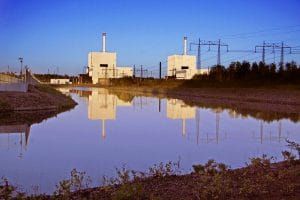
https://www.flickr.com/photos/vattenfall/3582015616
In most countries that host nuclear power plants, establishing an accurate picture of the economics of the electric sector is far from trivial due to a collection of market interventions known as “policy instruments.” These include renewable energy credits or certificates,[2] renewable purchase obligations,[3] renewable portfolio standards,[4] and carbon offsets,[5] which often make it challenging for utilities (or the public) to untangle true costs. Also, the relative competitiveness of different energy technologies is clouded by carbon taxes,[6] cap-and-trade agreements[7] on fossil fuel-powered electricity generation, and tax-and-credit schemes that advantage one energy technology over others. This is especially the case if the implementation of these schemes is intentionally opaque.
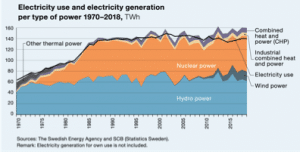
Sweden’s national energy sector has not only minimized these kinds of issues but is sufficiently transparent to allow effective untangling of the economics. Sweden reached a virtually fully decarbonized electricity sector by the 1970s, as illustrated in Figures 1 and 2. This sector is currently dominated by hydroelectric and nuclear, with the balance of electricity generated using biofuels (mostly focused on what Sweden refers to as “combined heat and power”) and a growing wind and solar photoelectric sector. As a result, Sweden has not needed to transition its electricity sector within the past half century because it was largely decarbonized from the outset. Instead, the country’s ongoing energy transition is focused on developing an increased role for renewable energy sources, including on-shore and off-shore wind power.
A deep dive into Sweden’s nuclear power plant data
Elforsk, now known as Energiforsk, is a privately held nonprofit Swedish energy research center that has published multiple reports between 2011 and 2014 providing insight into current, commercially available technologies for nuclear power, solar power, hydroelectric power, and wind power (Jansson et al. 2014).
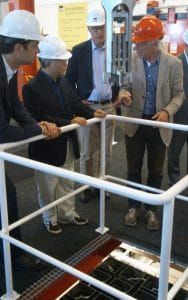
What do these reports reveal? In Sweden, nuclear power is the third cheapest low-carbon energy technology, preceded by wind onshore and large-scale hydroelectric power.[8] One important parameter used to calculate cost in these reports is the cost of capital, or the amount of return on a project necessary for investors to agree the project is worthwhile. There are two standard figures for the cost of capital used in the report: 10 percent and 6 percent. A higher cost of capital, in this case 10 percent, is usually indicative of a higher-risk project, such as a nuclear power plant. The electricity production cost for nuclear power is 57.95 öre[9]/kilowatt hour (kWh),[10] preceded by wind onshore at 54.73 öre/kWh and hydropower at 49.36 öre/kWh.[11] The 2014 electricity production cost excluding policy instruments is shown in Figure 3.
The most recent Elforsk report includes measurements of electricity production costs including policy instruments, excluding policy instruments, and including policy instruments except for electricity certificates or green energy certificates (Jansson et al. 2014). Policy instruments outside of electricity certificates include taxes such as property and power taxes, among others, and fees (Jansson et al. 2014).
All three of these measures result in slightly different cost breakdowns, but the latter two measures both result in the same initial ordered ranking of energy technologies. Following these cost measurement comparisons, nuclear energy is the third cheapest energy technology for electricity generation, preceded by wind onshore and hydroelectric power. When including electricity certificates in the cost measurement, this changes slightly as the costs of hydroelectric and wind drop significantly, while the cost of nuclear stays the same.
All numbers taken from the Elforsk report have been converted from 2014 öre to 2020 öre by accounting for inflation using the Swedish consumer price index. In 2014, there was an additional cost to consumers for nuclear power in the form of an added thermal power tax. In 2016, the Swedish government decided to phase out this tax as part of a larger renewable energy agreement that restructured the makeup of the Swedish energy portfolio and set a goal of achieving complete reliance on renewable energy by 2040. This thermal power tax was fully phased out by 2018. The thermal power tax was projected to cost roughly 0.05 SEK/kWh, or 5 öre/kWh, to producers (Jansson et al. 2014). The other primary tax on nuclear power, the nuclear waste tax, was approximately 5.2 öre/kWh[12] in 2018 (Vattenfall). Holding other fees equal, the removal of the thermal power tax effectively cut the tax effect on nuclear power in half. This resulted in a minor adjustment of nuclear power’s electricity production cost from 57.95 öre/kWh to 57.77 öre/kWh, which did not change the rankings of the energy generation alternatives. Said differently, the thermal power tax was not an effective policy intervention.
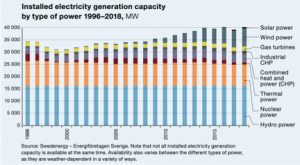
In addition to information about the cost of production, the data from the Elforsk report provide insight into the production efficiency of energy technologies. The load factor is a key production efficiency variable, given by the number of hours per year divided by the expected full load hours of each energy source. The load factor for nuclear energy is 95 percent, more than double the expected load of the next most efficient source of energy (Jansson et al. 2014). The other low-carbon energy technologies follow, with hydroelectric at 46 percent, wind offshore at 42 percent, wind onshore at 33 percent, solar industrial and park at 11 percent, and finally solar home at 10 percent (Jansson et al. 2014).
The Elforsk report is one of the most comprehensive collections of Swedish energy data, but there are reports that gather similar information at a smaller scale. “Electricity Production in Sweden” (Byman 2016), the background report for the Royal Swedish Academy of Engineering Sciences’ (IVA) Electricity Crossroads project, aims to create an understanding of how energy technologies work together to provide full market coverage, but in the process produces much of the same data as is found in the Elforsk report.
Sweden’s efficient and cost-competitive nuclear energy sector
In many countries, including in the United States, both the public and policymakers cite high and unpredictable costs as a primary argument against including nuclear power in a decarbonized energy portfolio. Yet in Sweden, a country with an almost fully decarbonized electricity sector, nuclear power is extremely competitive considering real cost. Real cost is the cost of electricity excluding any economic incentives such as renewable energy credits or carbon taxes. Nuclear is the third cheapest low-carbon energy technology (described above). It is also the most production-efficient low-carbon energy technology. Nuclear power has almost three times the load factor of wind onshore, while only being 3.2 öre/kWh more expensive. When compared to hydroelectric power, nuclear has more than double the load factor and is 8.7 öre/kWh more expensive than large hydro plants and 2.1 öre/kWh less expensive than small hydro plants, working out to just 2.2 öre/kWh more expensive than the average hydroelectric power plant.
When including economic incentives designed to make renewables more competitive, small hydropower plants and large offshore wind farms become cheaper than nuclear power, but nuclear remains cheaper than small offshore wind farms and all forms of solar power (at both 6 percent and 10 percent cost of capital) despite these subsidies. These policies achieve their intended goal of making renewables more affordable, but given its efficiency, nuclear power remains a competitive low-carbon energy technology even with the subsidized effect of electricity certificates.
Assuming a situation in which other “less risky” forms of energy operate at a 6 percent cost of capital and only nuclear operates at a 10 percent cost of capital due to investor uncertainty, nuclear power shifts one place to become the fourth cheapest low-carbon energy technology, tied with large offshore wind farms at 80.48 öre/kWh. These data show that no matter how you compare low-carbon energy technologies—both including and excluding the effect of renewable subsidies—nuclear energy is competitive by cost and by efficiency.
In 2016, the Swedish government adopted a new agreement on renewable energy policy, with the goal of reaching 100 percent renewable energy production by 2040, superseding the Nuclear Power Phase-out Act of 1980.[13] This agreement explicitly states that this target date is not a deadline for banning nuclear power, nor does it mean closing nuclear power plants. The agreement prohibits reintroducing the Nuclear Power Phase-Out Act and allows for granting permits to replace currently operating reactors and building new ones. While the lede of the agreement seems to suggest that the government is all in on renewables, the text makes clear that Sweden is a long way from giving up the competitive advantage of nuclear power.
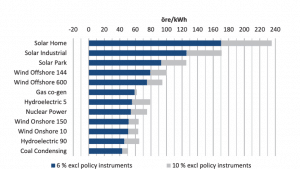
Sweden’s low-controversy, carbon-free electric grid
The substantial cost disparities between modern renewable energy sources and existing nuclear power seen in the United States are not evident in Sweden. While nuclear power is not the cheapest source of electricity in Sweden (wind and hydro are), the relatively small cost difference (of order $0.01/kWh) is compensated by the substantially greater nuclear power capacity factor. While this conclusion is based on data through 2018, there have not been significant changes to Sweden’s electricity markets that would modify the conclusion.
The Swedish national electricity grid (which is relatively well integrated into the northern European grid, with good cross-border links to both Norway and Denmark) does not substantially rely on grid-scale energy storage. Also, Sweden produces a considerable electricity surplus which, instead of leading to curtailments as in the United States, is exported to its neighbors at highly advantageous prices.[14] This surplus also provides a buffer against in-country power production fluctuations, substantially easing the challenge of managing a grid subject to significant generation fluctuations resulting from renewables such as wind-power. This buffering relies on a source of highly reliable base power. Given Sweden’s high capacity for nuclear power, such an energy source is indeed available.
Finally, Sweden’s government was proactive in dealing with many of the key issues bedeviling US nuclear power. For example, Sweden has been working toward successfully managing long-term storage of nuclear waste. In particular, the Swedish Nuclear Fuel and Waste Management Company was established in 1972 by the Swedish nuclear power industry to deal with nuclear waste, following an earlier period in which the disposal of nuclear waste was extremely controversial and politically sensitive. This company identified a final repository site in Forsmark in 2009 after a highly public and transparent selection process that allowed for local veto power of any site selection. Then it applied for permission to build a final repository and the associated fuel treatment infrastructure, based on a nuclear waste repository solution in the form of copper canisters in 2011, as well as to expand an existing interim used fuel storage facility known as the Clab. Two regulatory bodies—the Environmental Court and the Radiation Safety Authority—reviewed this plan, and the Swedish government’s executive branch was expected to decide within the next few months whether to grant the company the construction license needed to begin work on the canisters, based on the opinions previously submitted by the regulatory bodies.
This decision was expected in the first half of 2021 but was delayed due to conversations about possibly separating the decisions regarding the Clab expansion and the repository. On August 26, 2021, the government announced[15] that it would indeed separate these two decisions and gave the go-ahead to begin the Clab interim storage expansion, but it postponed the decision about the final repository. They justified this choice by acknowledging that electricity production would be significantly hindered in Sweden if intermittent storage were not expanded before 2023. Given bureaucratic delays, a decision on the final repository is unlikely by the end of the year. If permission will be granted, as is expected, the Forsmark repository should take about 10 years to build. Whether this government decision to split approval of these construction projects puts three of Sweden’s reactors—Forsmark units 1, 2, and 3—at high risk of early closure appears to be a matter of dispute, with Vattenfall (the owner and operator of the Forsmark reactors) warning of this possibility and the government disagreeing. This disagreement is unfortunate but not surprising. As one of few countries actively pursuing a final repository, Sweden is uncovering regulatory dilemmas that are likely to arise for other countries in the future. Nevertheless, the transparent, deliberative, and collaborative Swedish approach to nuclear power has ensured that nuclear power is far less controversial than in the United States, while also maintaining a carbon-free electric power sector.
ENDNOTES:
[1] Carbon capture and sequestration involves technologies for capturing carbon dioxide at its production site and then permanently removing it from the environment, such as storage in deep geological repositories. Alternatively, carbon dioxide may be removed from the environment by industrial reuse of this gas (Office of Fossil Energy and Carbon Management n.d.).
[2] Renewable energy credits or certificates are tradeable legal assets representing renewable energy and are used to confirm the generation or use of renewable energy.
[3] Renewable purchase obligations are policies that require all generators to purchase a minimum percentage of total electricity requirements from renewable sources.
[4] Renewable portfolio standards are policies that require electricity suppliers to provide a minimum percentage of electricity from renewable sources.
[5] A carbon offset is a reduction in greenhouse gases through some mechanism (such as planting trees or carbon capture and storage) to offset greenhouse gas emissions elsewhere, measured in metric tons of emissions.
[6] A carbon tax creates a financial burden (additional tax) for each ton of carbon dioxide emitted by generators and businesses.
[7] A cap-and-trade agreement sets a cap on and commodifies emissions. This allows entities that emit fewer greenhouse gases to sell their remaining allowable emissions to more polluting entities.
[8] The average output for large hydro plants in Sweden is 90 MW, and Energiforsk commonly refers to this class of hydro plants as “hydroelectric 90” in order to distinguish them from the large number of smaller hydro plants. However, the hydroelectric 90 group generates most of the total hydro energy in Sweden (22,471.6 GW/yr out of a total of 25,550.67 GW/yr, or 88%; cf., Appendix 1 of Rudberg 2013).
[9] An öre is equivalent to 1/100 of a Swedish krona (SEK), or the centesimal subdivision of the krona. It is no longer in active use for commercial transactions
[10] For the current (01-09-2021) exchange rate (1 SEK = 100 öre = $0.121921), these costs translate to $0.071/kWh (nuclear), $0.067/kWh (wind onshore 150 and 10), and $0.060 (hydroelectric 90).
[11] These calculations exclude the policy instruments and assume a 6 percent cost of capital adjusted for inflation using the Swedish Consumer Price Index with October 2020 as a reference point. Referencing October 2020 against October 2014 gives a CPI adjustment factor of 1.073084517 (SCB 2021).
[12] It is useful to note that this nuclear waste tax, which translates to approximately $0.006/kWh, is six times the so-called “mill fee” which was charged to US electricity customers using electricity generated by nuclear power plants. As of 2014, the United States stopped collection of this fee.
[13] This legislation, passed by the Swedish Riksdag in 1980, followed the US Three Mile Island accident of 1979 and a national referendum on nuclear power in Sweden (which endorsed the elimination of nuclear power); it specifically prohibited any new construction of nuclear power plants in Sweden, and targeted 2010 as the date by which Swedish nuclear power would terminate.
[14] For example, the published electricity price (including taxes) in neighboring Denmark in 2020 was €0.2833/kWh, while the comparable electricity price in Sweden was €0.1826/kWh (https://ec.europa.eu/eurostat/statistics-explained/index.php/Electricity_price_statistics)
[15] https://www.world-nuclear-news.org/Articles/Swedish-government-delays-repository-decision
Together, we make the world safer.
The Bulletin elevates expert voices above the noise. But as an independent nonprofit organization, our operations depend on the support of readers like you. Help us continue to deliver quality journalism that holds leaders accountable. Your support of our work at any level is important. In return, we promise our coverage will be understandable, influential, vigilant, solution-oriented, and fair-minded. Together we can make a difference.
